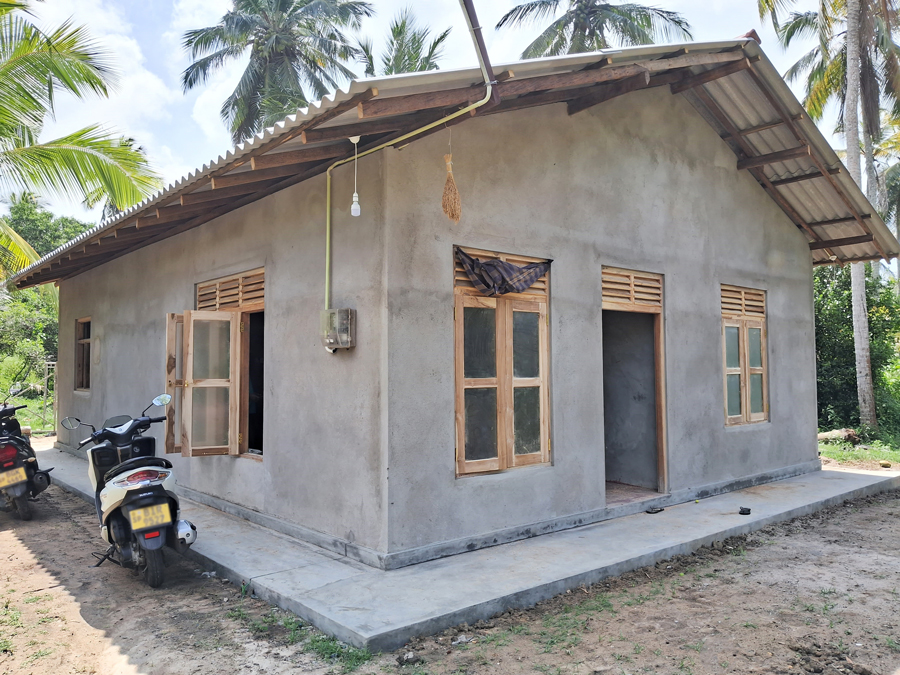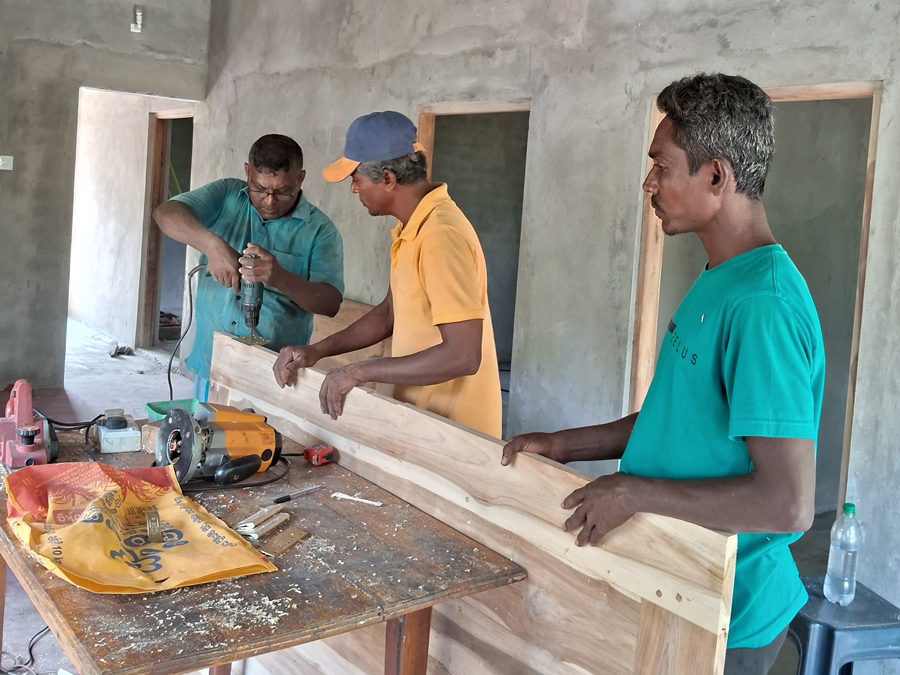Our Views
International Women’s Day 2024: Meet Janet McKelvey, Co-Founder of TRIP Canada
03/07/2024
As we celebrate International Women’s Day (IWD), the story of Janet McKelvey and TRIP Canada emerges as an emblem of hope and the power of one individual to instigate monumental change.
McKelvey first travelled to Sri Lanka to provide short-term aid in response to the Boxing Day tsunami in 2004, which left 110,000 Sri Lankans homeless, 35,000 dead or missing, and 250,000 with no means of support. After that first trip, McKelvey and her husband, Bruce McKelvey (co-founder of TRIP Canada) quickly realized they could do more.
Since 2005, McKelvey and TRIP Canada have built over 60 homes in Sri Lanka, helped more than 50 Sri Lankans with post-secondary education, raised millions of dollars, and created over 250 volunteer experiences in an ongoing effort to build sustainable communities and transform lives. In recognition of her efforts, McKelvey was awarded the Order of Ontario in 2022, and both Janet and Bruce have received Canada’s Meritorious Service Award.
This International Women’s Day, Newport took an opportunity to talk with McKelvey about TRIP Canada and how this year’s IWD theme of inspiring inclusion resonates with her mission and vision.
We know that TRIP Canada was born in the wake of the horrendous tsunami that affected many parts of Southeast Asia in 2004, but was there a personal connection for you with that event?
JM: After many years of working for large corporations, including Xerox, I didn’t want to do the “big corporate thing” anymore. I wanted to focus on giving back. I spent the last five years of my career at Canadian Tire helping the company develop its philanthropic strategy. When the tsunami hit, I felt compelled to do something more than just write a cheque. I needed to go there.
I did some research on volunteer vacation companies that were doing relief work and found an American organization that was doing projects in Sri Lanka. I joined them in April 2005, just months after the tsunami.
What was that first trip like?
JM: It was eye-opening and life-changing, revealing the sheer magnitude of the disaster but also the capacity for change. We were there for two weeks building houses with volunteers from around the world. I was inspired by the young people on my team from Great Britain, Australia and the United States. As I watched how they embraced the experience, it struck me that this would be an incredible opportunity for a younger person in their twenties and thirties to have.
There weren’t any Canadians on that trip, so when I got back, I said to Bruce that I thought we should go back one more time with a team of Canadians to help with the home-building efforts. I approached Developing World Connections in Kamloops, because they had a site in Sri Lanka where we could bring a team of volunteers to work. We set a target date of December 2005.
How did you put a team together?
JM: We started by sending out messages to everyone we knew, and our extended network. And of course, what happened was that many people just couldn’t physically go on the trip, but they wanted to donate money. As we got more money, we got a little cocky, and said to Developing World Connections, “If you find a piece of property, we’ll buy it and build a village.” They found a few acres for $20,000—and, along with our good friends, Richard and Joan Boxer, we bought it.
A local team then put together a plan for a village of houses, a community centre and a temple. We went overnight from taking a team of volunteers to Sri Lanka to building a village for 24 families. That was in September of 2005.
So here you are, with a bit of cash, not much of a team in place, a grand ambition to build a village—and just three months to go before your trip. How did you pull it all together?
JM: Well, that’s how we first got connected to Newport. The company’s chairman, Aubrey Baillie, brought together the senior partners to meet with us and they collectively and personally donated $25,000. That was a significant head start on the $200,000 we needed to raise to build everything. But we did it and got a team together too.
It took us 14 months to build the village, and we took three volunteer teams over during that time. We finished in February of 2006.
What kept the momentum going? What made you decide to keep going back to Sri Lanka?
JM: For that project, we employed 14 Sri Lankans who kept the work going when the volunteers weren’t there. We got to know them really well, and when the project was done, Bruce and I looked around at that circle of faces. While they were helping build the village, their own living conditions remained pretty awful. We were all crying, and we immediately knew that we couldn’t just leave. So, we made a commitment to them. If they would do the labour, we would provide the materials and resources to help them fix their own homes.
TRIP Canada was born, and we’ve been going to Sri Lanka every year since then. We’re in the process of building our 65th house, which will be dedicated to Newport, in recognition of that crucial early commitment and their unwavering support since that time.
We’ve also built two schools, two temples, and an addition for an orphanage.

TRIP Canada’s 65th house, which will be dedicated to Newport Private Wealth

The community in Sri Lanka coming together to build the house
TRIP Canada is also committed to education. Tell us more about that.
JM: Our initial focus on building homes naturally extended to helping families thrive and break the cycle of poverty. Our early work led to a deeper understanding of what was important to the communities we were helping: education and family. Our mission evolved, and we created a scholarship fund to educate their kids and help them qualify for university.
To date, our sponsors have helped educate more than 50 students who may have otherwise not have had the opportunity to attend university.
It takes a lot of money and resources to make initiatives like this happen. How are you able to keep raising the money year-over-year?
JM: To be honest, many of the same people and organizations who donated back in 2005 continue supporting us to this day. I run a fundraising campaign once a year, usually in September or October, that raises enough to build three to four houses every year, and each of our university students in the scholarship program is personally sponsored by volunteers or other donors.
Over COVID, our donor-base actually expanded, so we’ve been able to increase to four to five houses per year.
We are very focused on letting people know what their dollars are going towards. Bruce and I cover all of the administrative costs of the program, so virtually 100% of the donations go directly to support TRIP Canada’s work on the ground. That, along with the word-of-mouth around volunteers sharing their experiences, seems to inspire donations.
What are some of the bigger challenges you’ve faced, and what challenges might you face in the future?
JM: Uncertainty is often the biggest challenge. I never know how many volunteers I’m going to get, and I never really know how much money I’m going to raise. There’s also the uncertainty of working in a developing country. Sri Lanka went through the tsunami. They went through a traumatic civil war. There were the 2019 Easter terrorist attacks, the terrible, ongoing economic crisis and COVID. So many uncontrollable things. But that’s what they are: uncontrollable. So, we try not to worry about them, and keep moving on.
With your role at Canadian Tire, and the work you’re doing in Sri Lanka, it’s clear that philanthropy has always been important to you. What inspires you, and what would inspire a young person reading this to take action?
JM: It’s never the big things. I’ll get an email from a student, a young woman we helped put through school that I haven’t heard from in years. She’ll share what she’s doing, a picture of her teaching at the school where she works, a photo of her baby. It’s those unplanned moments that inspire me.
It’s also learning what we can do. When I first went, I was astonished to find myself capable of contributing to the construction of a house, and it was motivating to witness individuals of all ages achieving remarkable feats.
There is something about this experience that changes people. Watching a new volunteer go on a trip, seeing them become part of the experience, building relationships with a family, playing with kids, and doing the work. It’s an amazing evolution to watch.
What is the most important thing you’ve learned since you started the TRIP Canada mission?
JM: We can all make a difference. I’m reminded of the story about the boy and the starfish.
A man was walking along the beach when he noticed a boy picking up a starfish and throwing it into the ocean. He asked the boy what he was doing. “Throwing starfish back into the ocean. The tide is going out. If I don’t throw them back, they’ll die.”
The man said, “There are so many miles of beach, and so many starfish. You can’t make a difference.”
The boy bent down, picked up another starfish and threw it into the ocean. “I made a difference for that one.”
We hear volunteers say, “I never knew that one person could make a difference. But going on this trip I see that one person can make a difference. I know I changed other people’s lives, and it changed my life too.”
Janet McKelvey’s vision, rooted in compassion and unwavering dedication, serves as a powerful reminder of the impact one individual can have, inspiring us all to make a difference, one starfish at a time.
To find out more about TRIP Canada and Janet McKelvey’s inspiring mission and vision, please visit: https://www.tripca.org/
Subscribe to Our Views
*Please refer to our Privacy Policy to find out how we protect your information